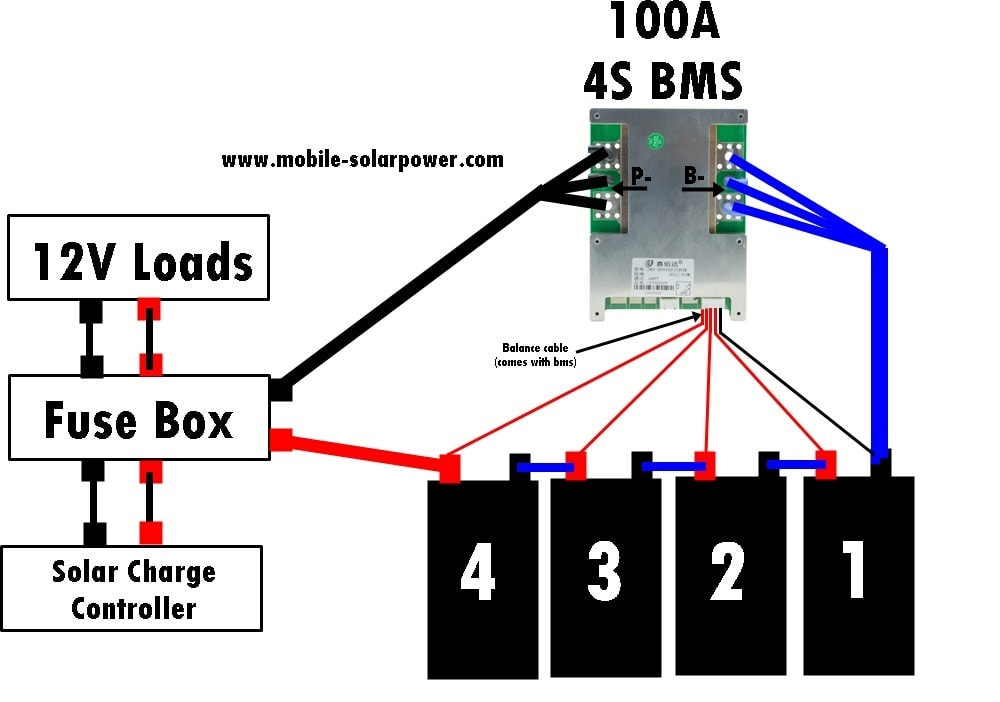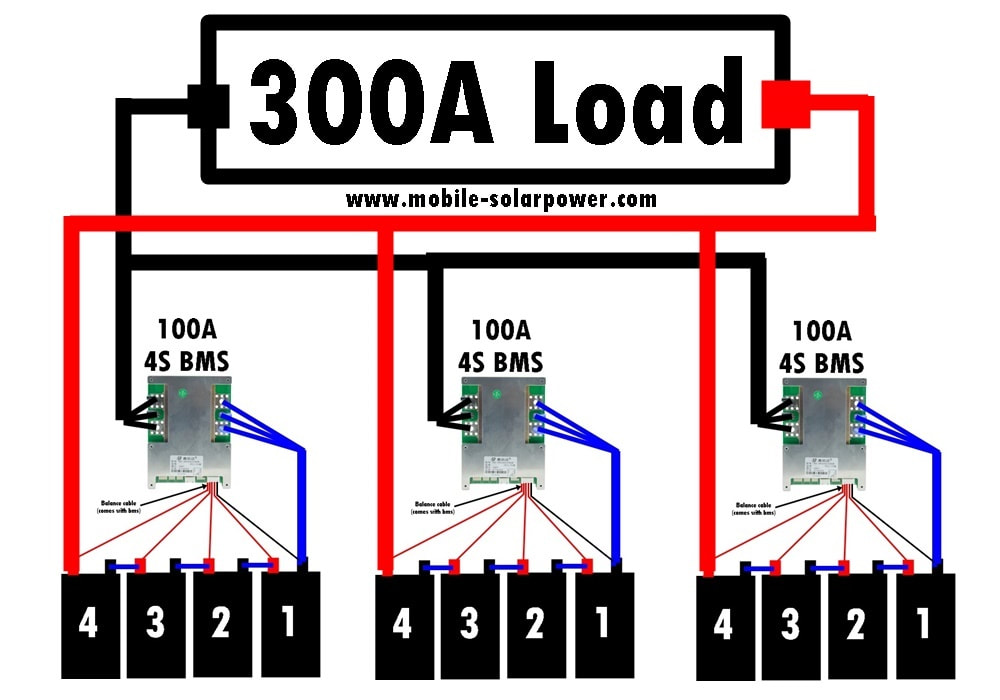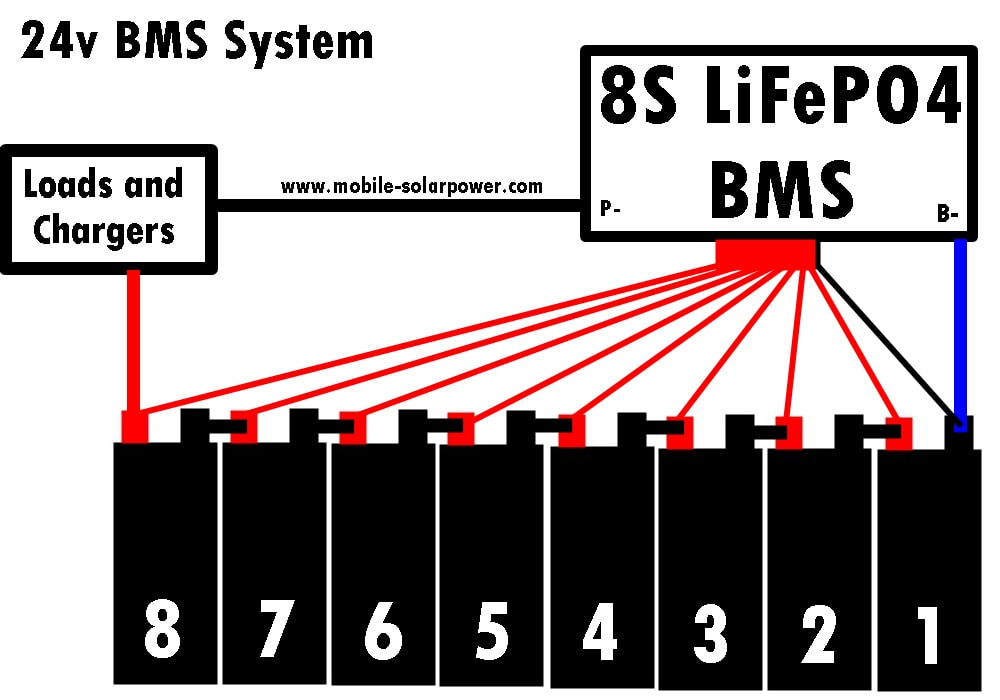Build your own Lithium Battery Bank.
How big does your BMS need to be? Simple! Say your running a 5000w inverter with 48v, so just divide 5000w / 48v = 105amp, but remember that most inverters have a peak watt’s as well! So 5000w might be it’s ‘running’ power but it may peak at say 8000w for a certain amount of time, thus your BMS need’s to cover this as well! i.e 8000 / 48v = 166amp, so in this case a 200amp BMS should cover everything with a safe limit as well. Same goes 12v – 24v etc! 3000w / 12v = 250amp as a minimum
Build projects on this page are demonstrations of what you can do fairly simply.
This is a complete system solution complete with:
- BMS Protection Features (over/under voltage/over-current/balancing)
- Low Temperature Cut-off
- Programmable Charge/Discharge Bandwidth Settings
- Matched LiFePO4 Cells that will last for ages
- Low-voltage disconnect options for large inverters
- Make it as large as you want! Power a small village or home if you want
All at a great price. This is the ultimate DIY LiFePO4 based system and has everything you need for a system that will last at least 10 years.

If A Single BMS Cannot Handle The Current Required By Your Loads, Make 3X Individual Batteries And Put Them In Parallel:

If You Wish To Run A LARGE Inverter (Or Any Load Larger Than 2000W), Build A 24v/48v System:
Running a solar power system at 12V is pretty illogical when you need to run large inverters. You will spend a TON of money on BMS/Wire/OCPD etc.
So to save yourself a lot of time and money, build a higher voltage battery bank. This will allow you to run a massive inverter with a single 100A BMS. Let’s think about this for a second…
- If you run 12V, a 100A BMS can run a 1,200W load max
- If you run 24v, a 100A BMS can run a 2,400W load max
- If you run 48v, a 100A BMS can run a 4,800W load max!
On top of that, 320A 48v BMS are easy to find! And cheap (like the one at the bottom of this page) and can power 15,360 watt loads!!
You will also save a ton of money in wire costs alone (hundreds of dollars worth usually). So if you are powering any load that is larger than 2000W, run a higher voltage battery. You will save yourself a lot of time and money.
 lithium battery bank” width=”1000″ height=”700″ />
lithium battery bank” width=”1000″ height=”700″ />How To Configure Cells In A Large Battery Bank
If you are building a large battery bank, you should buy larger cells. If the largest size cells cannot do the job, you will need to combine cells in parallel first, then connect them in series.
This will allow you to build and manage a large battery bank with a single BMS.
When you parallel your cells, they need to be nearly the same voltage. If you buy brand-new cells, they will come at the same voltage and you can wire them up like this:


Recommended Charge Profile:
12V LiFePO4 Battery w/ BMS:
Absorption: 14.5V
Float: 13.6V
Inverter Cut-off: 10.7V-12V (depending on size of load and voltage drop etc)
24V LiFePO4 Battery w/ BMS
Absorption: 29V
Float: 27.2V
Inverter Cut-off: 21.4V-24V
48V LiFePO4 Battery w/ BMS
Absorption: 58V
Float: 54.4V
Inverter Cut-off: 42.8V-48V
Individual 3.2V LiFePO4 Raw Cell (for individual cell capacity testing)
Absorption: 3.625V
Float: 3.4V
Low voltage disconnect for capacity testing: 2.5V
If you are using a BMS and wish to manually cycle up to 90% SOC:
Do a discharge capacity test with a shunt. Record capacity in watt hours.
Charge slowly up to 90% SOC (take capacity Watts figure and multiple by .9), and while charging, record the voltage right when it hits 90% SOC
Set the absorption for all chargers in system to the voltage you recorded in step 2
5,000+ Charge Cycle Absorption Recommendation
If you want your LiFePO4 cells to last a long time, you can set your absorption to Victron’s custom LiFePO4 charge profile recommendation:
12V Battery: 14.1V
24V Battery: 28.2V
48V Battery: 56.4V
You can pull full capacity with the absorption figures above, but the charge rate will be reduced at high SOC
Credit goes to Mobile Solar Power
